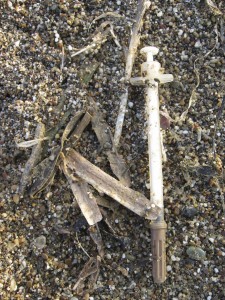- Tahoe’s Nevada Beach Tops the List of Hard-to-Book Campgrounds - 07/17/2024
- Cannabis Watershed Protection Program Cleans Up Illegal Grow Sites - 07/10/2024
- French Fire - 07/05/2024

Medical waste washing up on New Jersey beaches was a big problem in the late 1980s, closing beaches along a 50-mile stretch of the New Jersey shore. Although that problem was addressed for the most part, bacterial contamination from sewage treatment outflows, contaminated storm water and other sources caused more than 24,000 beach closures or advisories across the U.S. last year. Pictured: a washed-up syringe. Image credit iStock
I remember that medical waste, washing up in New Jersey, I believe, was a big issue in the late 1980s. Is it still today?
— Walter Maliszewski, Camden, NJ
Medical waste washing up on New Jersey beaches was a big problem in the late 1980s, closing beaches along a 50-mile stretch of the New Jersey shore. Officials scrambled for months to figure out where the waste was coming from, and eventually zeroed in on New York City’s Fresh Kills Landfill on Staten Island. Sub-optimal systems there were not successfully containing medical waste and other garbage on site, and New Jersey beaches—and vacationers and business owners—were paying the price. Although no one was injured or exposed to disease by the washed up waste, the public was especially alarmed given the HIV/AIDS crisis gripping the nation at that time. New York City was required to pay $1 million for past pollution damages and had to shoulder the cost of clean-up at Jersey Shore beaches as well.
The resulting loss of tourism cost business owners throughout the affected region as much as 40 percent of their revenue, with total losses estimated at well over $1 billion. Some New Jersey business owners remain upset that New York wasn’t forced to pay them reparations for lost revenue as well.
In the wake of the scare, Congress enacted the Medical Waste Tracking Act in 1988, requiring the U.S. Environmental Protection Agency (EPA) to create a program to better track medical waste from cradle-to-grave so that it didn’t end up fouling beaches or any other environments. While the program was not renewed when it expired in 1991, it served as a model for how states and municipalities could better track potentially dangerous medical waste while also helping medical facilities institute systems and processes for making sure they knew where their waste was going and that it would be disposed of responsibly.
Meanwhile, New York and New Jersey have coordinated on setting up and maintaining their own systems to stem the so-called “syringe tides.” The cornerstone is a multi-agency program designed to intercept debris within New Jersey Harbor before it can get to tourist-crowded Jersey Shore beaches. Thanks to the plan—which relies on surveillance by environmental groups as well as routine and special clean-up sweeps by the U.S. Army Corps of Engineers and the implementation of a communications network to facilitate the reporting of incidents and quick responses—beach closures declined from more than 70 miles in 1988 to less than four miles in 1989, with closures remaining at similarly low levels ever since.
Of course, medical waste is hardly the only problem facing America’s beaches and coastal waters. According to the non-profit Natural Resources Defense Council (NRDC), bacterial contamination from sewage treatment outflows, contaminated storm water and other sources caused more than 24,000 beach closures or advisories across the country in 2010 alone. NRDC reports on water quality at U.S. beaches every year in its series of “Testing the Waters” reports. Pressure from the group has helped spur the EPA to agree to overhaul Clean Water Act regulations pertaining to urban and suburban storm water runoff and update decades-old beach water quality standards by 2012. These improvements should help to keep beaches from the Jersey Shore to the Great Lakes to California, and points in between, clear of debris and safe for swimmers and sunbathers of every stripe.
CONTACTS: NRDC Testing the Waters, www.nrdc.org/water/oceans/ttw; Medical Waste Tracking Act of 1988, www.epa.gov/osw/nonhaz/industrial/medical/tracking.htm.
EarthTalk® is written and edited by Roddy Scheer and Doug Moss and is a registered trademark of E – The Environmental Magazine (www.emagazine.com). Send questions to: earthtalk@emagazine.com. Subscribe: www.emagazine.com/subscribe. Free Trial Issue: www.emagazine.com/trial.













